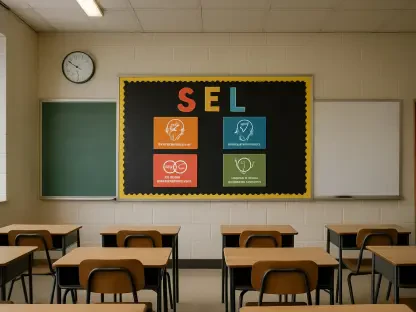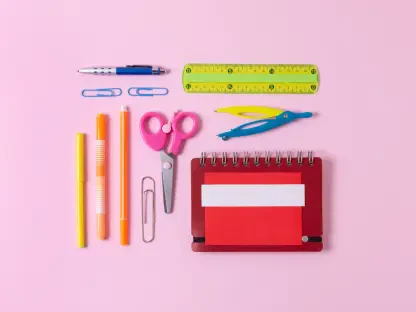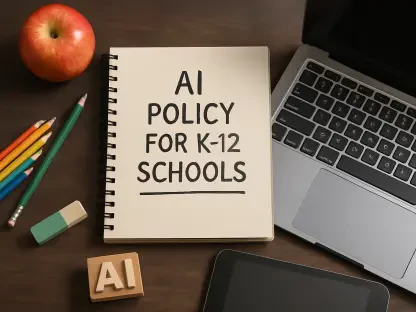In a rapidly evolving world where AI and automation are transforming industries, the skills demanded by the workforce are shifting dramatically. Traditional skills are now complemented by creativity, adaptability, and technological fluency. To prepare students for this future, educational institutions must pivot towards integrating creative technology tools into their curriculums. This article delves into how schools can harness such tools to equip students with essential skills for tomorrow’s job market, drawing insights from Brian Johnsrud, the director of education learning and advocacy at Adobe.
The Changing Landscape of Workforce Skills
Evolution of Essential Skills
By 2027, skills like creative thinking, analytical or critical thinking, and technological literacy will be paramount. The World Economic Forum forecasts a significant shift towards these cognitive and adaptive skills over traditional static knowledge. Employers are increasingly prioritizing lifelong learners who can adapt and self-direct their learning, thus making a “skilling revolution” inevitable. This shift underscores the urgent need for educational curriculums to be continually updated to meet the demands of the ever-changing workforce. The goal is not only to keep pace with these changes but to equip students with a dynamic skill set that can navigate and thrive in varied professional landscapes.
Educational systems must focus on nurturing creativity and problem-solving abilities, which are essential in a world where AI and automation handle routine tasks. Analytical and critical thinking are no longer supplementary but have become cornerstones of a competitive skillset. Students need to develop technological fluency, particularly in areas like AI and machine learning, to be successful in future careers. The education sector must emphasize these evolving skill requirements and integrate them systematically into learning frameworks to adequately prepare students for the future.
Lifelong Learning and Adaptability
Adaptability is increasingly crucial in an ever-changing job market. Rapid technological advancements mean that students must learn to pivot and adapt continuously throughout their careers. Cultivating skills such as curiosity for lifelong learning and resilience is essential if students are to navigate unforeseen challenges and seize emerging opportunities. These skills can be seamlessly integrated into education to ensure students are not just prepared but are resilient and flexible in their professional endeavors.
Embedding adaptability into educational curriculums involves fostering a mindset of continuous improvement and growth. Students should be encouraged to ask questions, seek new knowledge, and remain open to new experiences. This approach not only prepares them for the current job landscape but also equips them with the agility to face future technological shifts. Education systems must recognize that learning doesn’t end with graduation; it continues throughout one’s career. Therefore, fostering lifelong learning and adaptability ensures that students can maintain relevance and competitiveness in a rapidly evolving workforce.
Integrating Creative Tools in Education
Real-World Skill Application
Equipping students with industry-standard tools, such as Adobe’s suite, prepares them for professional environments. These tools provide practical, hands-on experiences that mirror real-world scenarios, facilitating a smoother transition from academic to professional settings. By familiarizing students with the technologies they will encounter in their careers, schools can significantly enhance their employability and readiness for the workforce. This practical application of learned skills ensures that students don’t just learn in theory but are also capable of implementing their knowledge effectively.
Moreover, students gain a competitive edge when they enter the workforce with proficiency in commonly used professional tools. This competence can differentiate them from their peers and make them more attractive to potential employers. Using these industry-standard tools in educational settings also allows students to produce high-quality work that meets professional standards. This experience contributes to a portfolio of work that students can showcase to future employers, further bolstering their career prospects and demonstrating their capability.
Project-Based, Experiential Learning
Using professional-quality templates and assets, students can engage in project-based learning that fosters practical skills and allows for the creation of authentic outputs. This method combines theoretical knowledge with hands-on practice, ensuring that students develop a well-rounded skill set. Experiential learning emphasizes the importance of doing and reflecting, which is crucial in internalizing knowledge and skills. Projects that mirror real-world challenges make the learning process more engaging and applicable, giving students a clearer understanding of how their education translates to their future careers.
Project-based learning encourages students to take initiative, think critically, and solve problems innovatively. It nurtures a proactive mindset and equips students with the confidence to tackle new challenges. By working on projects that simulate real industry problems, students develop a deeper understanding of their field and gain valuable insights into professional expectations and standards. This learning approach also fosters collaboration and teamwork, essential skills in any professional setting, and prepares students to work effectively in diverse teams.
Fostering Collaboration Through Creative Technology
Collaborative Learning Environments
Creative tools that support collaboration enable students to co-create, share feedback, and develop ideas collectively. This collaborative approach is crucial in modern workplaces that value teamwork and idea-sharing. Tools like these facilitate an environment where students learn the importance of collective effort and the value of diverse perspectives. Collaborative learning nurtures communication skills and teaches students how to work effectively in team settings, skills that are increasingly important in today’s interconnected and globalized work environment.
Collaboration in educational settings prepares students for professional environments where teamwork is often a requirement. By engaging in collaborative projects, students learn to navigate group dynamics and leverage the strengths of their peers. They also become adept at giving and receiving constructive feedback, an essential skill for personal and professional growth. The ability to work well in a team, share responsibilities, and achieve common goals is a significant advantage in the competitive job market, and educational systems must prioritize developing these skills.
Accessible Yet Advanced Tools
Tools like Adobe Express for Education offer an accessible entry point for beginners while providing advanced features for more proficient users. This “low floor, high ceiling” design means students can grow their skills progressively, encouraging continuous learning and development. Such tools are particularly beneficial as they cater to varying skill levels, ensuring that all students can engage with the technology and advance at their own pace. This approach promotes inclusivity and ensures that no student is left behind in the learning process.
Accessible yet advanced tools make learning more inclusive by catering to students with different levels of technological proficiency. Beginners can start with simpler features and gradually explore more complex functionalities as they become more comfortable and confident. This progressive learning curve helps maintain engagement and motivation, as students can see their improvement over time. Advanced users, on the other hand, are not limited by the tool’s capabilities and can continue to challenge themselves and innovate. This balance makes the learning environment more dynamic and adaptable to individual learning needs.
Overcoming Creative Confidence Challenges
Encouraging Initial Steps
Many students hesitate due to a lack of confidence in their creative abilities. Providing well-designed templates can help them move past the initial “fear of the blank canvas,” allowing them to focus on content rather than design elements from scratch. Templates serve as a starting point, giving students the structure they need to begin their projects with confidence. This support not only helps them get started but also encourages them to explore their creativity without the intimidation of starting from zero.
Templates can significantly ease the entry into creative tasks by providing a foundation that students can build upon. As students become more familiar with the tools and processes, they can gradually move away from templates and create original designs. This progression helps build their creative confidence and encourages them to experiment and innovate. By lowering the initial barrier to entry, educators can foster a more supportive environment where students feel comfortable expressing their creativity. This initial support plays a crucial role in helping students develop the confidence to tackle more complex and original projects.
Building Confidence through Iteration
Encouraging students to experiment and iterate builds their creative confidence. This process instills a mindset where mistakes are viewed as learning opportunities rather than failures, fostering a resilient and innovative approach to problem-solving. Iteration is a fundamental aspect of the creative process, allowing students to refine and improve their ideas continuously. By embracing iteration, students learn that creativity is not about getting it right the first time but about evolving and enhancing ideas through ongoing effort and reflection.
The iterative process helps students develop a growth mindset, recognizing that creativity and skills can be developed over time. This perspective is essential for long-term success, as it encourages persistence and resilience. By providing opportunities for students to revisit and refine their work, educators can help them understand the value of continuous improvement. This approach not only builds creative confidence but also teaches important life skills such as patience, perseverance, and the willingness to learn from feedback and mistakes. These skills are invaluable in both academic and professional settings.
Comprehensive Support for Educators and Students
Resource Availability
Educators and students benefit greatly from comprehensive support resources. Adobe Express for Education, for instance, includes free lesson plans, instructional resources, and guided activities, helping maximize the tool’s potential. Providing these resources ensures that teachers are well-equipped to integrate technology into their curriculums effectively, while students have the guidance they need to make the most of their learning experiences. Comprehensive support bridges the gap between technology and education, making it easier for both teachers and students to navigate and utilize these tools.
Access to well-structured resources can significantly enhance the learning and teaching experience. Lesson plans and guided activities provide a clear framework for educators, helping them align technology use with educational goals. These resources also serve as a valuable reference for teachers, enabling them to troubleshoot and find solutions quickly. For students, having access to structured activities and resources supports independent learning and allows them to explore the tools at their own pace. This support system creates a more effective and impactful learning environment, where both educators and students can thrive.
Formal Recognition and Certification
Offering certification exams provides students with formal recognition of their skills. These certifications are valuable when applying to colleges or future employers, showcasing a student’s proficiency and commitment to continuous learning. Formal recognition validates the skills and knowledge that students have acquired, giving them tangible proof of their abilities. This recognition can be a significant advantage in academic and professional contexts, as it demonstrates a student’s dedication and expertise.
Certifications act as a bridge between education and employment by clearly signaling a student’s competencies to potential colleges and employers. They provide a standardized measure of proficiency, making it easier for students to showcase their skills in a competitive job market. Additionally, the process of preparing for and attaining certification can enhance a student’s confidence and motivation. By setting clear goals and working towards achieving them, students cultivate a sense of accomplishment and readiness for future challenges. This formal recognition not only benefits the students but also reassures educators that their teaching methods are effective and aligned with industry standards.
The Role of AI in Enhancing Creativity
Rapid Brainstorming and Iteration
AI can boost creativity by facilitating rapid brainstorming sessions and allowing for swift iteration. This capability helps students generate, refine, and enhance ideas efficiently, aligning educational paradigms with modern technological advancements. By leveraging AI, students can explore a wide range of possibilities quickly, making the creative process more dynamic and innovative. AI tools can provide instant feedback and suggestions, helping students consider different angles and improve their work iteratively.
Integrating AI in educational settings empowers students to push the boundaries of their creativity. AI can assist in overcoming creative blocks by offering new perspectives and ideas, making the brainstorming process more fluid and productive. The ability to iterate rapidly allows students to test and refine their ideas continuously, leading to more polished and innovative outcomes. This synergy between AI and human creativity fosters an environment where students can experiment without fear of failure, ultimately enhancing their creative confidence and skills.
Shifting Educational Focus
In a swiftly changing world, where AI and automation are revolutionizing various sectors, the skills required by the workforce are shifting significantly. No longer is it enough to rely solely on traditional skills; today’s workers must also possess creativity, adaptability, and an understanding of technology. To adequately prepare students for this evolving job landscape, educational systems must shift towards incorporating creative technology tools into their curriculums.
This article explores ways in which schools can utilize these tools to arm students with the essential skills needed for the future job market. Insights are drawn from Brian Johnsrud, the director of education learning and advocacy at Adobe. According to Johnsrud, integrating creative technology into education is not just beneficial but necessary. These tools can foster a blend of critical thinking, creative problem-solving, and technological fluency among students. By incorporating such technologies, schools can help students to not only keep up with but also drive the advancements in tomorrow’s industries. In essence, the aim is to ensure that students are well-prepared for the complexities of future career landscapes.









